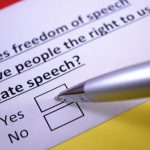The Offence of Publicly Threatening or Inciting Violence in NSW

Sunday, 11 December 2005 was a day of national shame for Australia.
By midday, around 5,000 Anglo-Australians had converged on Cronulla beach to secure their ‘revenge’ against people of “Middle Eastern descent”, after an alleged altercation on 4 December 2005 between Australians of Lebanese descent and lifeguards at the beach.
The altercation was widely publicised in the mainstream media, especially on talkback radio.
When a listener contacted 2GB days after the incident to report that “really derogatory remarks” were being made about people of “Middle Eastern descent”, host Alan Jones interrupted and stated, “We don’t have Anglo-Saxon kids out there raping women in Western Sydney”.
Mr Jones then repeatedly endorsed listeners who called in to encourage people to descend on Cronulla Railway station and the suburb generally to assault “Lebanese people”.
By Thursday, 15 December 2005, Mr Jones had incited significant racial hatred and bragged about it, stating among other things, that: “I’m the person that’s led this charge here. Nobody wanted to know about North Cronulla, now it’s gathered to this.”
He continued to incite hatred the following day, endorsing suggestions that Anglo-Australians engage in violence against persons of Lebanese and “Middle-Eastern descent”, who he labelled as “vermin” who “rape and pillage a nation that’s taken them in”.
The infamous Cronulla riots ensued – seeing a mob of intoxicated Anglo-Australians indiscriminately assaulting young men and women for simply being in the suburb of Cronulla.
The event was broadcast worldwide, bringing Australia into disrepute.
In 2009, the New South Wales Administrative Decisions Tribunal found that Mr Jones had indeed “incited hatred, serious contempt and severe ridicule of Lebanese Muslims” by his on-air comments. The Tribunal ordered that he apologise and pay $10,000 in damages.
Rather than reprimand Mr Jones, his employer, Harbour Radio, appealed the decision; but the appeal was dismissed in 2012.
Mr Jones has never been charged with a criminal offence over his conduct.
Commonwealth law: inciting a crime
Section 11.4 of the Criminal Code Act 1995 (Cth) contains the general offence of ‘incitement’, which provides that:
‘A person who urges the commission of an offence commits the offence of incitement.’
The section goes on to states that:
- A person may be found guilty even if committing the offence incited is impossible,
- Any defences, procedures, limitations or qualifying provisions that apply to an offence apply also to the offence of incitement in respect of that offence, and
- Any special liability provisions that apply to an offence apply also to the offence of incitement in respect of that offence.
This ‘catch-all’-type provision means that a person can be found guilty of a particular offence under Criminal Code Act – which applies across Australia – if they encourage another person to commit that particular offence.
So, for example, if a person encourages another to commit the offence of intentionally causing serious harm to an Australian citizen or resident under section 115.3 of the Act, he or she may be found guilty of that offence – whether or not the encouragement is due to the person’s beliefs or characteristics.
The offence is not applicable to attempts or conspiracies, and the penalties that apply are:
- 10 years in prison for offences punishable by life imprisonment,
- 7 years in prison for offences punishable by 14 years’ imprisonment or more,
- 5 years in prison for offences punishable by at least 10 years’ but less than 14 years’ imprisonment,
- 3 years or the maximum penalty, whichever is less, for offences otherwise punishable by a term of imprisonment, or
- the maximum applicable fine if the offence is not punishable by a term of imprisonment.
Commonwealth law: urging violence against members of groups
In addition to the law against incitement, section 80.2(1) of the Criminal Code prescribes a maximum penalty of 7 years in prison for urging violence against members of groups.
The section provides that:
A person (the first person) commits an offence if:
(a) the first person intentionally urges another person, or a group, to use force or violence against a person (the targeted person); and
(b) the first person does so intending that force or violence will occur; and
(c) the first person does so because of his or her belief that the targeted person is a member of a group (the targeted group); and
(d) the targeted group is distinguished by race, religion, nationality, national or ethnic origin or political opinion; and
(e) the use of the force or violence would threaten the peace, order and good government of the Commonwealth.
Section 80.2(2) prescribes a 5 year maximum penalty where subsection (d) above is not established.
NSW law: publicly threatening or inciting violence
Publicly threatening or inciting violence is an offence under section 93Z of the Crimes Act 1900 which carries a maximum penalty of 3 years in prison.
To establish the offence, the prosecution must prove beyond reasonable doubt that:
- You intentionally or recklessly threatened or incited violence towards another person or group,
- You did so by way of a public act, and
- You did so on grounds of the other person or group’s race, religious belief or affiliation, sexual orientation, gender identity, intersex status, or HIV or AIDS status.
A ‘public act’ includes:
- Any form of communication to the public, including speaking, writing, displaying notices, playing recorded material, and broadcasting and communicating through social media and other electronic means,
- Any conduct observable by the public, including actions, gestures, wearing or displaying clothing, signs, flags, emblems or insignia, and
- Distributing or disseminating any matter to the public.
The section makes clear that an act may be public even if it originates or occurs on private land
‘Race’ includes colour, nationality, descent and ethnic, ethno-religious or national origin and ‘religious belief or affiliation’ is defined as holding or not holding a religious belief or view.
‘Sexual orientation’ means a person’s sexual orientation towards:
- Persons of the same sex,
- Persons of a different sex, or
- Persons of the same sex and persons of a different sex.
‘Gender identity’ means the gender related identity, appearances, mannerisms or other gender related characteristics of a person without regard to the person’s designated sex at birth.
‘Intersex status’ means the status of having physical, hormonal or genetic features that are:
- Neither wholly female nor wholly male,
- A combination of female and male, or
- Neither female nor male.
‘Violence’ includes violence towards persons as well as property
To establish the offence, the prosecution does not need to prove that:
- Your views were incorrect or correct, or
- Any person formed a particular state of mind or carried out a violent act.
Proceedings for the offence can only be commenced with the approval of the Director of Public Prosecution.
Defences to the charge include:
- Duress,
- Self defence, including the defence of others, and
- Necessity.






